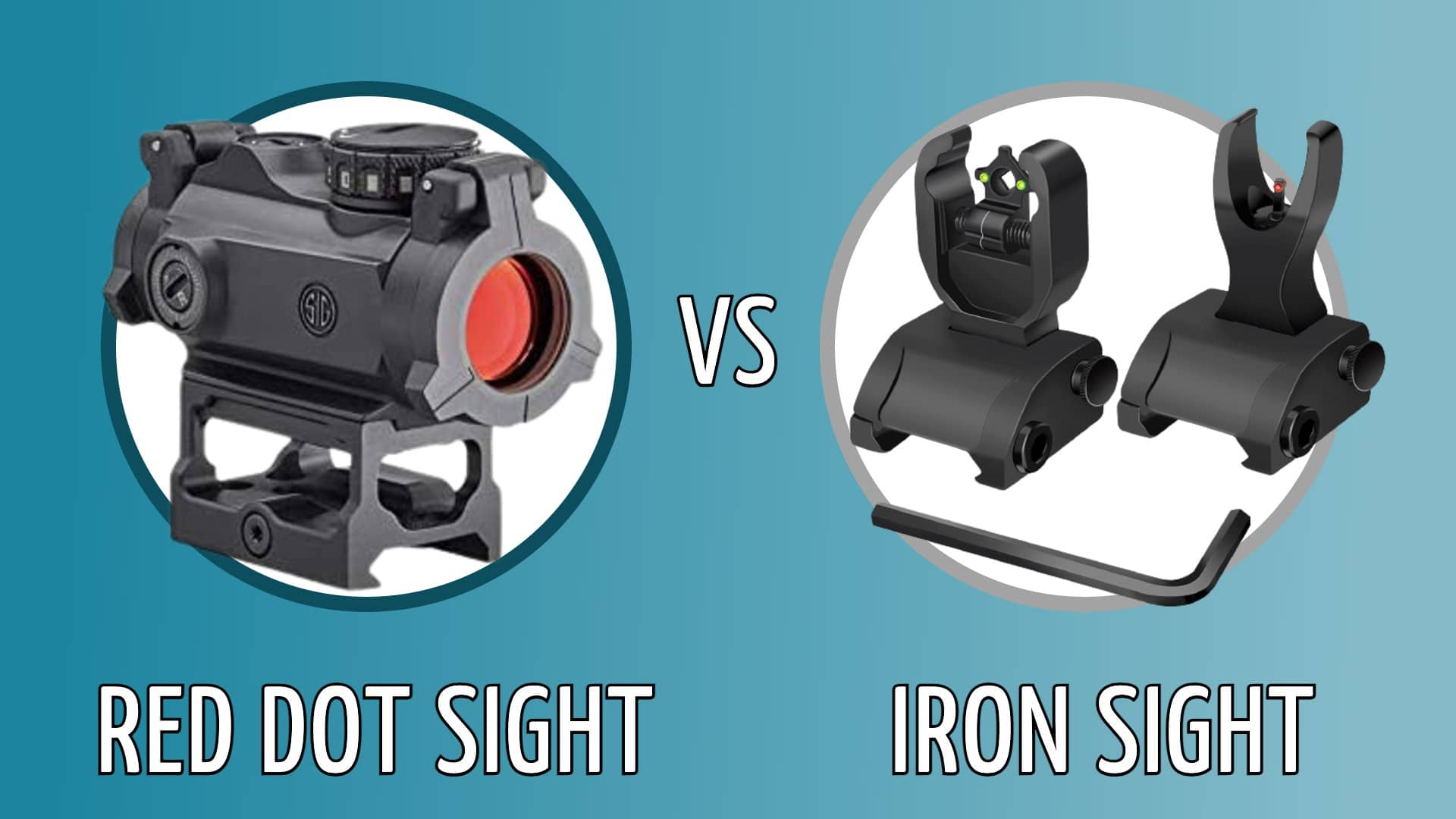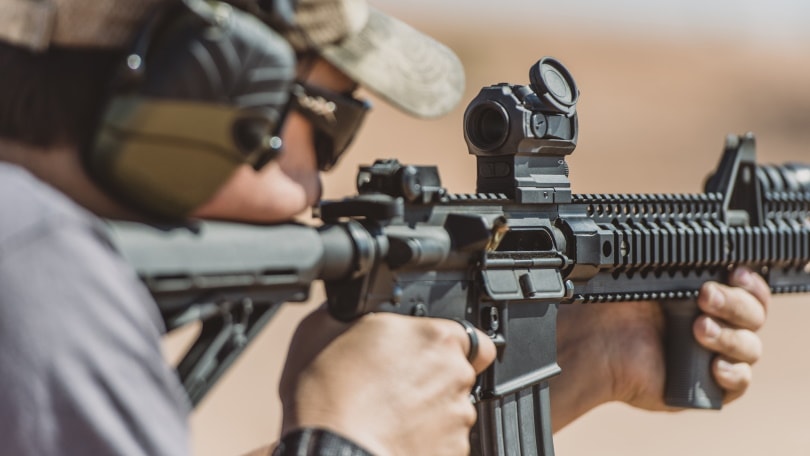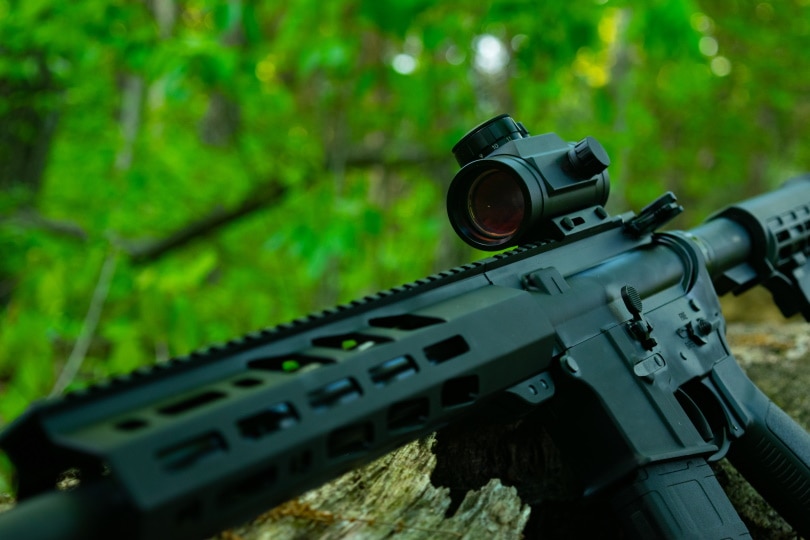Red Dot vs Iron Sights: Which is Better?
Last Updated on

You’ve seen both the red dot and the iron sight on tv with your favorite characters. It always seems the good guys are the one using the iron sights and they have no issue at all just getting a shot off. Or, you’ve seen the red dot in just about every first-person shooter game there is. Both have excellent qualities, but honestly, which is better?
Firing a firearm comes down to a few things. If your stance, grip, trigger control, draw, breathing, and follow-through are off, then no matter the sight you are going to fail. Let’s look at the difference between the two and see how they compare with one another.

Overview of Red Dot:

How it Works
The red dot is a sighting system that uses a red dot, though sometimes it is green, reticle as the aim point. There are a few different options on the market, including a holographic sight, but the principle is still the same. The only difference is the image that you are going to be able to see and the price tag.
The red dot uses a LED to project a reticle onto a lens that is coated to only reflect red light. As you look through the lens, the coating absorbs the other colors, leaving you with just red light coming towards you. The best part is only you can see the red dot, your target or anyone else looking would only see your eye.
While this isn’t new technology, it has improved since its founder Sir Howard Grubb of Ireland invented the reflex sight in 1900.
What it’s Good For
The best place to use a red dot is if you are doing short-range shooting or defense. This type of sight wasn’t made for distance. To get the most out of this type of optic, it is best used between 0 and 100 yards. It is quick, you just point it, and you know you’re going to hit your target.
Red dots allow you to keep both your eyes open. Because you are getting a reflection, you don’t have to only use your dominant eye to shoot. There is also no eye relief. If you can see the dot, you can hit your target, which is why defense really shines with this type of scope.
These types of optics also work in low-light settings. In most of the red dot optics, you can change how intense the dot is showing. The brighter the light, the more likely you’ll need it high to see just like your phone. At night you won’t need it as blinding.
- Quick and easy to use
- Different colors available
- Adjustable to light differences
- Keep both eyes open
- Not good for long distance
- More expensive

Overview of Iron Sights:

How it Works
You’ve probably seen the iron sight system for years and just may not have known what it was called. This type of sight consists of two parts. Part one is mounted at the front of the firearm and the second is at the rear. The typical look of this system is a post-and-notch setup. A notch is cut out into the rear sight and the post is at the front.
When using this system, the front post has to be centered horizontally and vertically within the notch in the rear. The front sight is then aligned with the target. This takes time to get down as if the sight isn’t aligned properly, the target will be missed or hit where you didn’t want.
Iron sights have been around for ages, making them one of the oldest systems to use. This type of sight has been seen all the way back to 1543, and the idea remains pretty much the same.
What it’s Good For
A seasoned shooter can use an iron sight for just about anything. Overall, the best practice for this type of sight is going to be hunting, target practice, or tv shows where there is no actual shooting happening. These sights are slower than our red dot because of the aligning of the post and notch system.
Because this type of sight requires a minimum of three points of alignment, it is slower. There is no getting around that this type of sight takes time to set up to aim. Someone who has had practice with this sight could grow to be just as fast, since skill level plays a role.
- Easy to find
- Been around for centuries
- Harder to use
- Slower than red dot
You might also be interested in: 8 Best Red Dot Scopes for AR-15— Reviews & Top Picks

Red Dot vs Iron Sights – Other Factors to Consider
Risk Management

Risk management is where the red dot really shines. There is a big difference between keeping both eyes open and one eye closed. Why do we close one eye with the iron sight, anyway? Well, that comes down to reducing the information the brain is being fed during aiming. It gives the brain less visual data to work through, but it also leaves you with one eye closed and half your vision gone.
The red dot allows you to have both eyes open, keeping your brain working and looking around for danger. It keeps you and everyone around you safer if you can see with both eyes open.
For shooting under stress, closing one eye actually goes against natural human tendencies. The brain wants to take in as much information as possible.
Accuracy Matters
With accuracy, the red dot is going to be superior. Yes, anyone who had used an iron sight can get the same result. However, the red dot makes it easier to get that accurate shot. There is no need to switch focal planes like the iron sight.
Those who have used both can see where the red dot becomes better. The dot makes it look like the target is wearing the dot rather than the dot just being placed on it. With an iron sight, you have to envision where you want the point of impact to be. Then you have to line up the notch with that point of impact. There is more work that goes into finding the alignment with an iron sight, and it isn’t guaranteed to be where you want to hit either.
If you are a master marksman, you may not have the issue of accuracy. However, for those who are starting out, the red dot allows you to see where the bullet is going to go without having to imagine it first.
Target Acquisition

While there is no doubt that an expert marksman on their worst day can shoot quicker and more accurately with an iron sight than an amateur with a red dot, the red dot is going to be faster in the long run. These types of optics were built for speed. The iron sights have their good points, but they were built to have time to aim and focus.
In a high-stress situation, the red dot is not only going to be faster, but it could mean the difference between getting a shot off and not. All you need to do with the red dot sight is place the reticle on your target. In a situation that could put you in danger, your brain wants to remain focused on that threat. The red dot allows you to do that while the iron sight actually pulls your focus away.
The iron sight is an impressive sight, but for spur-of-the-moment decisions the red dot has it beat. It doesn’t waste precious time like the iron sight would. Seconds matter in defending yourself against a threat, after all.

In Conclusion
In the end, the red dot sight wins out. For accuracy, speed, and safety, nothing can beat it. It allows your brain to work together to keep your focus on what is going on. Overall, keeping the focus on the target is going to win out during high-stress situations. Seconds are important and the red dot uses all of them wisely.
About the Author Robert Sparks
Robert’s obsession with all things optical started early in life, when his optician father would bring home prototypes for Robert to play with. Nowadays, Robert is dedicated to helping others find the right optics for their needs. His hobbies include astronomy, astrophysics, and model building. Originally from Newark, NJ, he resides in Santa Fe, New Mexico, where the nighttime skies are filled with glittering stars.
Related Articles:
Holy Stone Drone Review of 2024 – Pros, Cons, and Verdict
Ultraviolet Light vs Black Light: What’s the Difference?
Light Waves vs. Sound Waves: How Are They Different?
Infrared vs. Thermal Cameras: How Are They Different?
Far Infrared vs Near Infrared: What’s The Difference?
Mottled Duck vs. Mallard vs. Black Duck: What’s the Difference?
Shutter Speed vs Frame Rate: Pros, Cons, & Difference
Oriole vs Goldfinch: How to Tell the Difference
